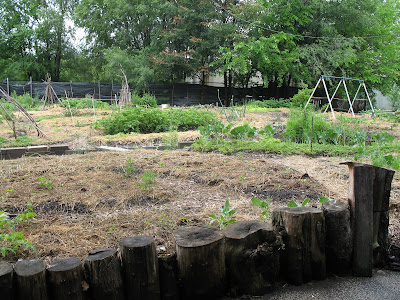
I was introduced to this book through one of my favorite publications, Mother Earth News, who gave this book a thumbs-up. Toolbox is an outpouring of experiences from the Rhizome Collective, an urban sustainability group out of Austin, Texas. Their goal right now (as of book publishing) is a cleanup of a 9.8 acre brownfield. That's incredibly aggressive, and I wish them the best.
After a quick read at work, Toolbox's greatest strength is the sheer number of ideas presented. In that sense, the book is a slam dunk, a Lebron James' alley-oop even. However, Toolbox has a handful of shortcomings. These include the shallow depth of some of the ideas presented, the shock-and-awe impracticalness of some of the ideas, silly illustrations, and a subliminal discouraging tone.
So, what ideas are presented? Cooking with solar ovens, raising chickens, biochar, biodiesel, micro-scale methane production, mushroom horticulture, aquaculture, phyto/myco-remediation, rainbarrels, gray water treatment, small-scale homemade wind turbines out of bike parts, composting, etc. After typing a list like that, I'm thinking, "hell-yeah!" However, Toolbox concludes in 215 short pages.
The chapters on rainbarrels, aquaculture, and raising chickens are the most complete chapters. I feel that I could use this book relatively well in doing any one of those functions with maybe a little more info needed for aquaculture. I could definitely make a solar oven and probably cook with it given these instructions, which I intend to later this summer. The section on phytoremeditation, including plants to use, is straight-forward enough and seems beneficial for a rust belt city like Almost Cleveland. With my scientific background, I'd like to see more formal studies of soil contamination, showing the levels of arsenic/lead before and after using these remediation plants.
I downright dislike the illustrations in this book and find them a complete waste of space. Juan Martinez must be a Rhizome Collective member, as that's the only way his illustrations make any sense in this book. On page 19, there's a whole page illustration of a 'possum-creature harvesting some unidentifiable mushroom from a stack of logs. Total garbage! Give me a real picture of real mushrooms growing on real logs, being harvested by a real person!
Considering the words "Sustainable City Living" are in the title, the Toolbox has some impractical, somewhat "shocking" ideas for city living. I'll present several examples. In the aquaculture section, the Toolbox suggests stringing raw meat above the pond in order to harbor maggots, which eventually fall into the pond for the fish to eat. Another is the outhouse for humanure composting. Last, there's a detailed section on insect cultivation. Maybe, these ideas will fly in Texan cities, a liberal Swiss commune, or in some less-developed countries; however, I can't hang a piece of raw meat to decompose in my city of Almost Cleveland.
I will conclude my gripes with the book's subliminal discouraging tone. I was all amped about aquaculture until I found out Tilapia don't grow in temperatures below 50 Fahrenheit. Native species of clams do not perform well in aquaculture settings (just leave clams out next pressing is my suggestion). The small-scale biogas digester will hardly boil water. The gray water treatment center for laundry water filtration would need to be re-hooked up to city water in the winter months in cities like Almost Cleveland.
In general, I love all the ideas presented in the Toolbox. This is the Toolbox's greatest asset. I'm glad these ideas are becoming more and more mainstream though not necessarily new for readers of Mother Earth News or its redneck cousin, Backwoods Home. I think the Toolbox definitely has its place in the general canon of sustainability. It's usage in a vocational high school/community college/university, coupled with a lab setting where projects are performed and other textbooks read, would be an awesome one-two punch for urban sustainability and general awareness everywhere (Obama listen up).
The other major take-home from this book in a implied way is urban sustainability is all about location. We all have many of the same tools. However, not all these tools are practical for everyone, everywhere.
The rust belt's a bitch with its four seasons, old homes with their lead paint and arsenic fences, and general blight/poorness. Given all these strikes against us, it presents the most opportunity for change/revolution for innovation in the sustainability movement. Here we go.
 It looks like a beauty. Don't she? Two acres of city-owned undevelopedness within eight minutes drive from my house. Plus, I got the community buy-in from the WCSBer. Of course as the old adage goes, if it looks too good to be true...
It looks like a beauty. Don't she? Two acres of city-owned undevelopedness within eight minutes drive from my house. Plus, I got the community buy-in from the WCSBer. Of course as the old adage goes, if it looks too good to be true...













